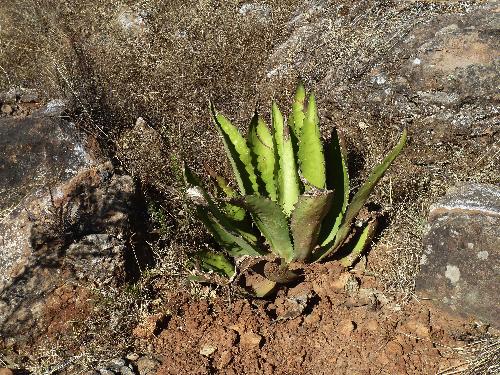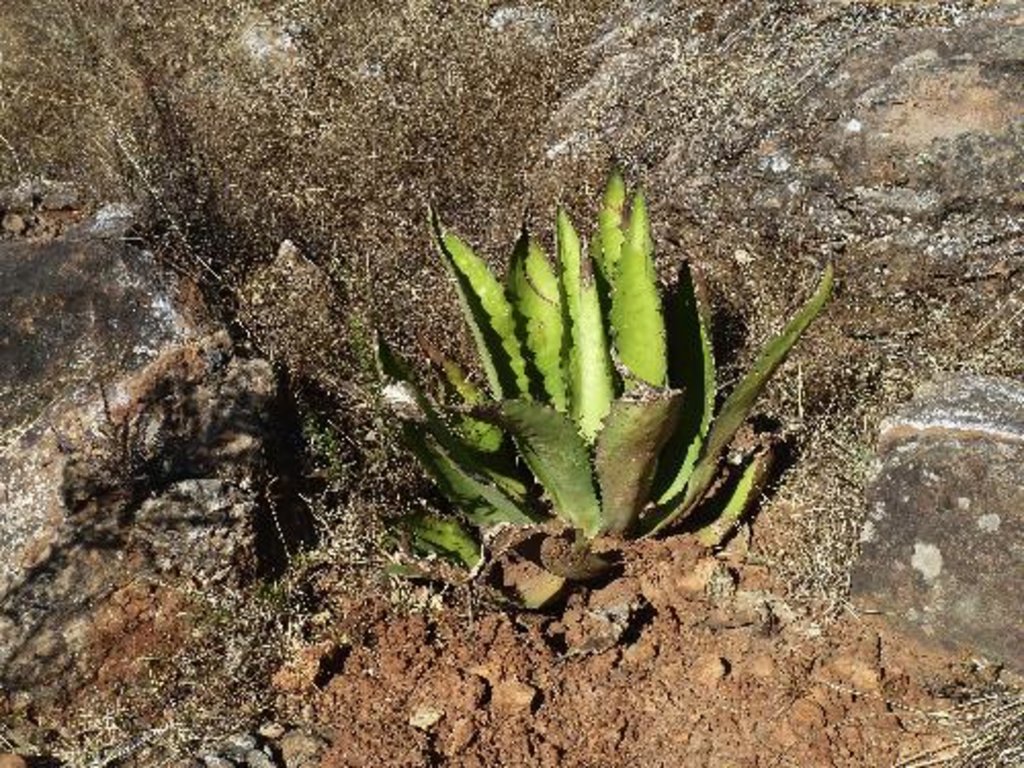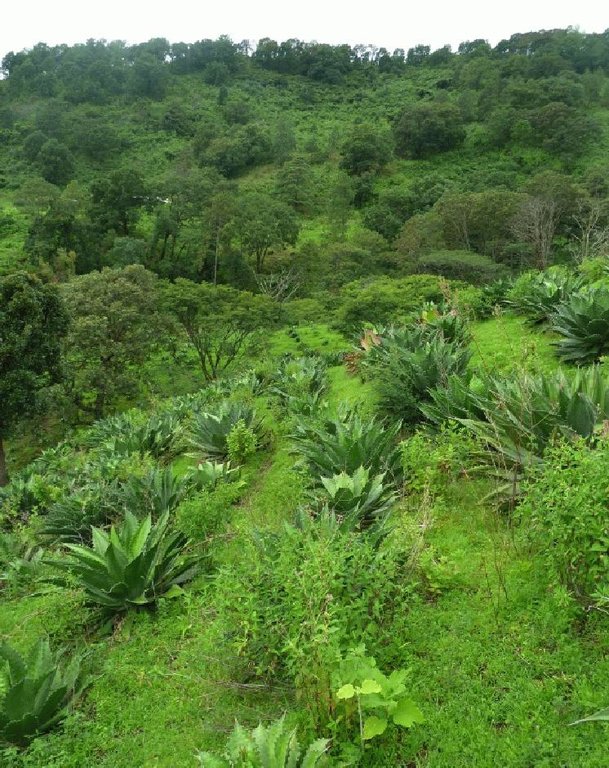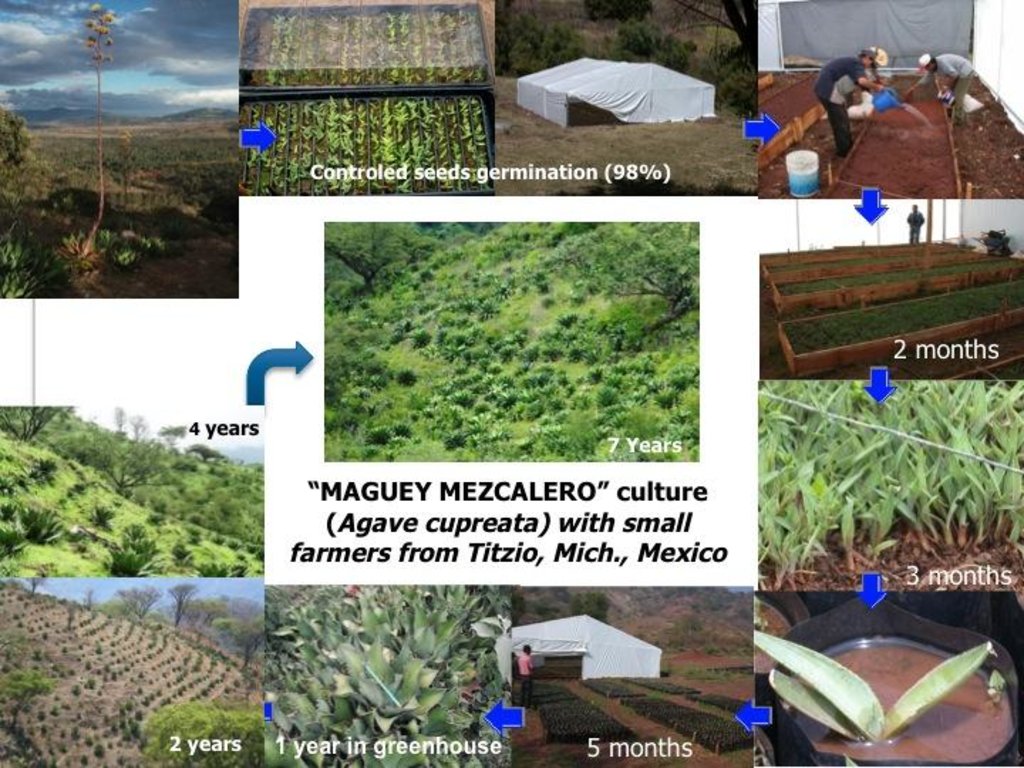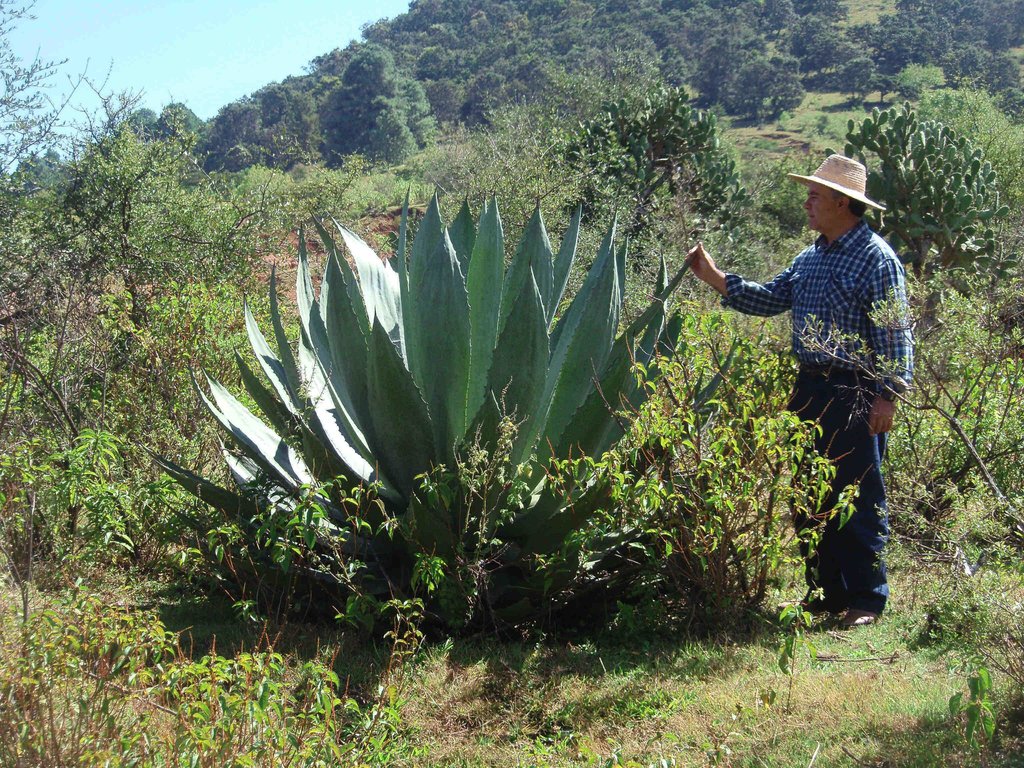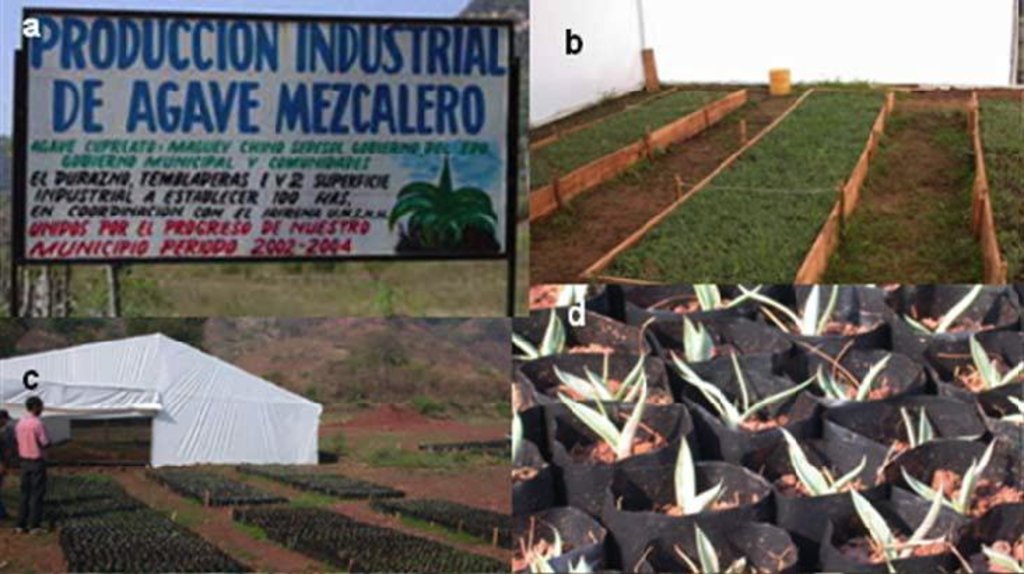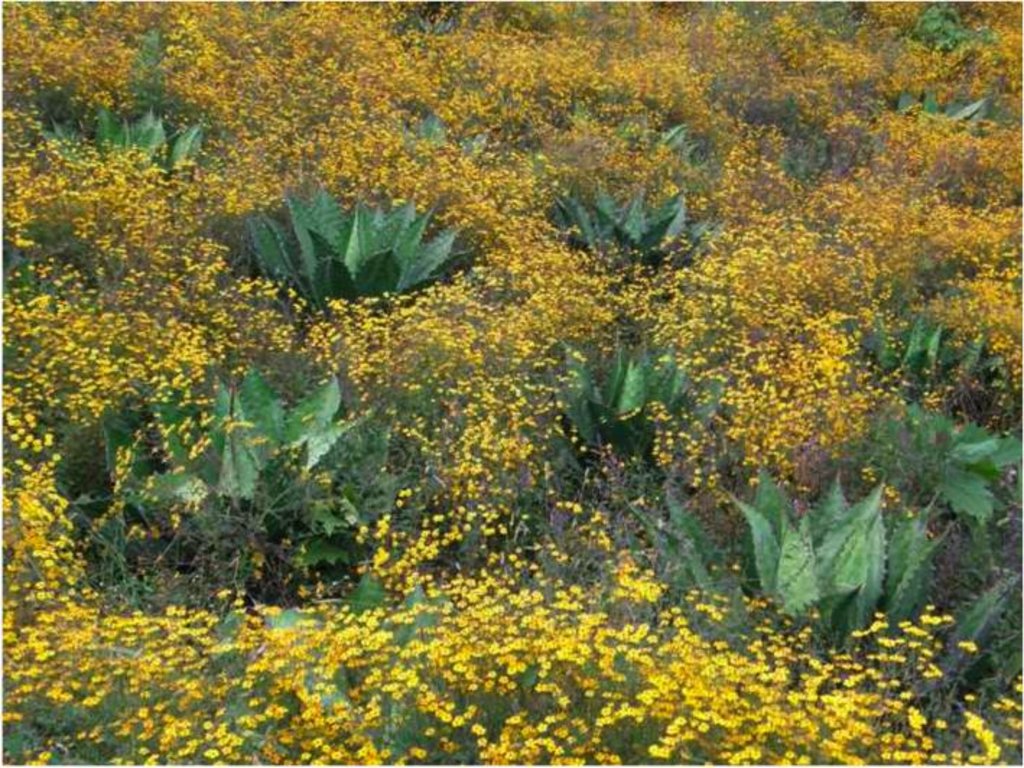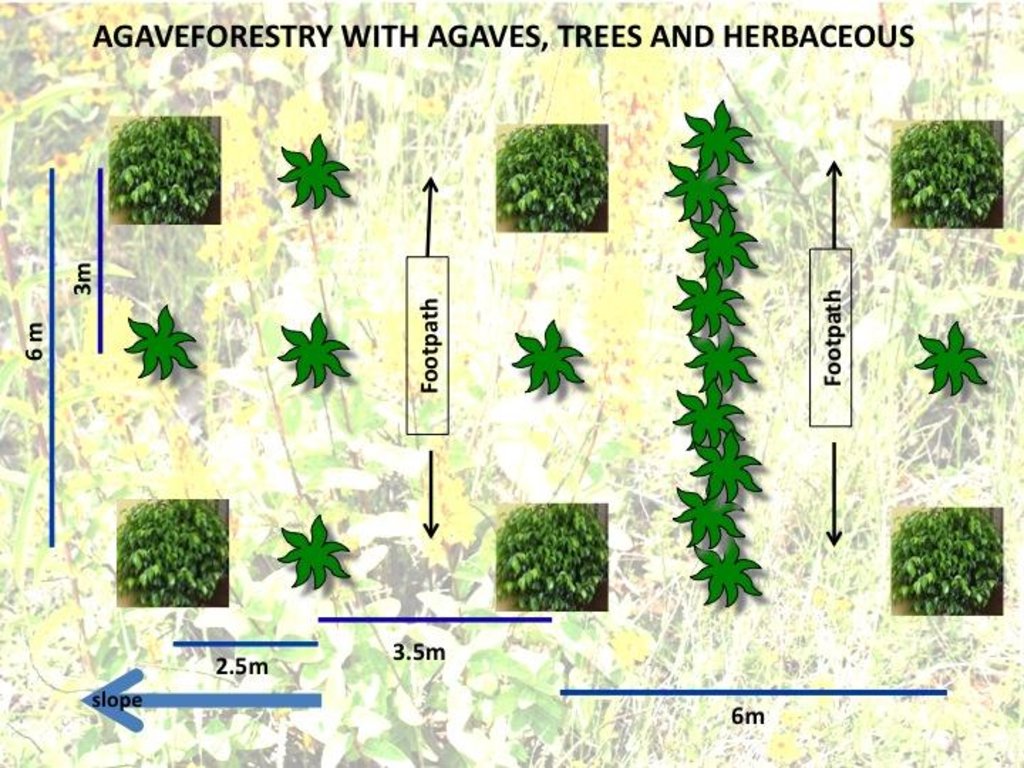Land reclamation by agave forestry with native species [Мексик]
- Шинийг нээх:
- Шинэчлэх:
- Эмхэтгэгч: Christian Prat
- Хянан тохиолдуулагч: –
- Хянагч: David Streiff
Recuperación de tierras degradadas por agaveforestería con especies locales de agaves, arboles y herbaceas (Spanish)
technologies_1114 - Мексик
Бүлгүүдийг үзэх
Бүгдийг дэлгэх Бүгдийг хаах1. Ерөнхий мэдээлэл
1.2 Технологийг үнэлэх, баримтжуулах ажилд хамаарах мэдээлэл өгсөн хүмүүс, байгууллагуудын холбоо барих мэдээлэл
ГТМ мэргэжилтэн:
Martínez Palacios Alejandro
(443) 334-0475
apalacios56@gmail.com
Instituto de Investigaciones Agropecuarias y Forestales, Universidad Michoacana de San Nicolás de Hidalgo
km 9.5 carr. Morelia-Zinapecuaro, Tarímbaro, Michoacán 58330
Мексик
ГТМ мэргэжилтэн:
Ríos Patrón Eduardo
(443) 322-6017
eduardo.rios@semarnat.gob.mx
Delegación de SEMARNAT en Michoacán, Unidad de Planeación y Política Ambiental
Morelia, Michoacán
Мексик
Технологи баримтжуулах/үнэлэх ажилд дэмжлэг үзүүлсэн төслийн нэр (шаардлагатай бол)
DESIRE (EU-DES!RE)Технологи баримтжуулах/үнэлэх ажилд дэмжлэг үзүүлсэн байгууллага(ууд)-ын нэр (шаардлагатай бол)
Instituto de Investigaciones Agropecuarias y Forestales (IIAF) - МексикТехнологи баримтжуулах/үнэлэх ажилд дэмжлэг үзүүлсэн байгууллага(ууд)-ын нэр (шаардлагатай бол)
Institut de recherche pour le développement IRD (Institut de recherche pour le développement IRD) - ФранцТехнологи баримтжуулах/үнэлэх ажилд дэмжлэг үзүүлсэн байгууллага(ууд)-ын нэр (шаардлагатай бол)
SECRETARÍA DE MEDIO AMBIENTE Y RECURSOS NATURALES (SECRETARÍA DE MEDIO AMBIENTE Y RECURSOS NATURALES) - МексикТехнологи баримтжуулах/үнэлэх ажилд дэмжлэг үзүүлсэн байгууллага(ууд)-ын нэр (шаардлагатай бол)
Universidad Michoacana de San Nicolás de Hidalgo (UMSNH) - Мексик1.3 ВОКАТ-аар баримтжуулсан өгөгдлийг ашиглахтай холбоотой нөхцөл
Мэдээллийг хэзээ (газар дээр нь) цуглуулсан бэ?
01/10/2010
Эмхэтгэгч болон гол мэдээлэгч хүн(хүмүүс) WOCAT аргачлалаар баримтжуулсан мэдээллийг ашиглахтай холбоотой нөхцлийг хүлээн зөвшөөрсөн:
Тийм
1.5 ГТМ-ийн Арга барилын талаархи санал асуулгын(д) суурь мэдээлэл
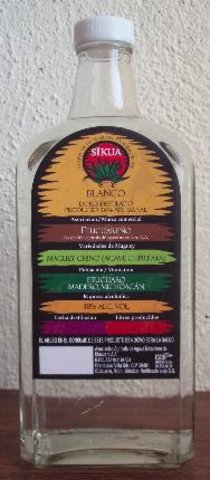
Participative actions for economic benefits of agave forestry [Мексик]
Land reclamation with local agave (to produce Mezcal) associated with trees, shrubs and grasses planted through participative actions for economic benefit.
- Эмхэтгэгч: Christian Prat
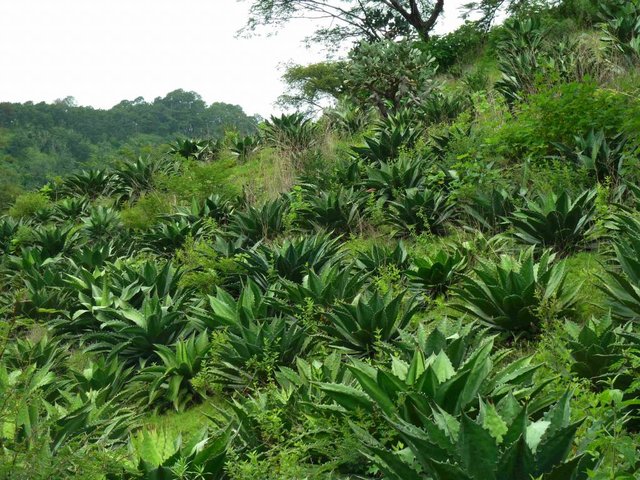
Land reclamation by agave forestry with native species [Мексик]
Land reclamation with local agave (to produce mezcal) associated wotj trees, shrubs and grasses planted through participative actions for economic benefit.
- Эмхэтгэгч: Christian Prat
2. ГТМ Технологийн тодорхойлолт
2.1 Технологийн товч тодорхойлолт
Технологийн тодорхойлолт:
Agave forestry land reclamation system with native agaves, trees, shrubs and grasses planted through participatory action for a sustainable production of mezcal and other products in order to generate high incomes for farmers.
2.2 Технологийн дэлгэрэнгүй тодорхойлолт
Тодорхойлолт:
Rehabilitation of degraded land is achieved using native agave (Agave inaequidens), trees and/or fruit trees, shrubs and grasses to create, over the medium-term (7-10 years), sustainable production of a traditional alcoholic drink (mezcal) made from agave and/or cosmetic and medicinal products, and/or fibres and/or fodder for cattle and/or wood. Between the agave plants, native vegetation is managed or planted for use as food, fodder and/or medicinal products. Depending on the slope and the level of land degradation, continuous planted rows of agave provide a ’green’ barrier that controls soil erosion and runoff.
Purpose of the Technology: The main purpose is to achieve sustainable land rehabilitation while generating a high income for the farmer. This allows reducing the amount of livestock and overgrazing, which is the main cause of soil erosion in this region. The production of mezcal gives local farmers high incomes. Trees, shrubs and grasses for medicinal uses, food, and fodder are complements of agave production and are processed mainly by women, while agave harvesting is a male activity. As it is very attractive financially, farmers stay in the communities instead of emigrating to cities or abroad. Biodiversity is preserved and increased using native plants (agaves, trees, shrubs, grasses). These plant associations are effective at controlling plant pests and diseases. Turning eroded into productive soil sequesters carbon and increases water availability as a result of the new soil cover.
Establishment / maintenance activities and inputs: Unlike most agave, Agave inaequidens reproduces from seed, which requires harvesting the seeds from native plants in the fields. One plant generates 80,000 seeds with a 90% success rate of germination, which is enough to cover 25 ha of agave forestry plantations set up to control soil erosion. After harvesting seeds from native agaves, trees and shrubs, seedlings and small plants are raised in a greenhouse and nursery managed by the owners and tenants of the land in the first year. At the beginning of the rainy season, these are planted in plots protected from cattle grazing for at least the first two years after planting. The harvesting activity for trees, shrubs and grasses is done annually, but for the agaves only once every 7 to 12 years depending on the degree of soil degradation. Some months before harvesting, the flower from the stem has to be cut. The leaves are then cut and left in the plot while the 50 kg heart of the agave (“piña”) is removed. Mezcal is produced from the heart and requires an average of three weeks and at least two men to process 25 agave plants (1.5 tonnes), which produces about 300 litres of mezcal.
Natural / human environment: Poverty levels in the area are medium to high and the income from agriculture accounts for only 10 to 20% of the total family budget. People, therefore, do not have time to install soil erosion protection systems in the fields. Cattle graze freely everywhere and the number of animals is increasing annually, which also increases soil erosion. Locals know how to produce mezcal, but they prefer to buy it from other people who take wild plants from their lands to process them. The proximity of the site to the Michoacán of Ocampo state capital and the recognition of the designation of origin for mezcal by the authorities will enhance its value for future production.
2.3 Технологийн гэрэл зураг
2.5 Энэ үнэлгээнд хамрагдсан технологийг хэрэгжүүлсэн улс орон/ бүс нутаг/ байршил
Улс:
Мексик
Улс/аймаг/сум:
Mexico/Michoacán state
Байршлын дэлгэрэнгүй тодорхойлолт:
Morelia municipality
Map
×2.6 Хэрэгжсэн хугацаа
Байгуулсан тодорхой оныг мэдэхгүй бол баримжаа хугацааг тодорхойл:
- 10-50 жилийн өмнө
2.7 Технологийн танилцуулга
Тайлбар (төслийн төрөл г.м.):
10 years ago, at Titzio, close to Cointzio basin, A. Martinez developped the culture of a wild native agave (Agave Cupreata) for alcohol production which was done traditionnaly for local consumming. We are following this project and objectives, but we are improving it for land remediation and soil erosion control too with a new species of native Agave (A. inaequidens)
3. ГТМ технологийн ангилал
3.1 Технологийн үндсэн зорилго (ууд)
- газрын доройтлыг бууруулах, сэргийлэх, нөхөн сэргээх
- үр ашигтай эдийн засгийн нөлөөг бий болгох
3.2 Технологи нэвтрүүлсэн газрын одоогийн газар ашиглалтын хэлбэр(үүд)

Холимог (тариалан/бэлчээр/мод), үүнд. ХАА-н ойжуулалт
- Агро-пасторализм
- ХАА-ой-бэлчээрийн цогц систем
Гол бүтээгдэхүүн/ үйлчилгээ:
semi perennial cropping (7-10 years): Agave inaequidens
annual: Herbaceous
tree cropping: Wood, fodder and fruits
Тайлбар:
Major land use problems (compiler’s opinion): Mainly overgrazing due to uncontrolled grazing by cattle.
Major land use problems (land users’ perception): Soil erosion by water due to the storms and improper land use.
Semi-nomadism / pastoralism: Yes
Forest products and services: timber, fuelwood, grazing / browsing, other forest products / uses (honey, medical, etc.), nature conservation / protection
Future (final) land use (after implementation of SLM Technology): Mixed: Mf: Agroforestry
Хэрэв технологи нэвтрүүлснээр газар ашиглалтад өөрчлөлт гарсан бол технологи нэвтрүүлэхээс өмнө байсан газар ашиглалтын хэлбэрийг тодорхойлно уу:
Grazing land: Ge: Extensive grazing land
3.3 Газар ашиглалтын тухай нэмэлт мэдээлэл
Технологи хэрэгжүүлсэн газрын усан хангамж:
- Байгалийн усалгаатай
Жилд ургамал ургах улирлын тоо:
- 1
Тодорхойлно уу:
Longest growing period in days: 190; Longest growing period from month to month: June to November
Малын нягт (шаардлагатай бол):
1-10 LU /km2
3.4 Технологи ГТМ-ийн аль бүлэгт хамаарах вэ
- хөрс/ ургамлын бүрхэвч сайжруулах
- Налуугийн арга хэмжээ
- ургамлын сорт / малын үүлдэр сайжирсан
3.5 Технологийн хамрах талбай
Технологи өргөн дэлгэрсэн эсхийг тодорхойл:
- газар дээр жигд тархсан
Технологи газар нутгийн хэмжээнд жигд тархсан бол түүний эзлэх талбайг дундажаар тооцож тэмдэглэ:
- 0.1-1 км2
Тайлбар:
630 km2 is the area of the Cointzio watershed. Untill now (2010), 10 ha have been managed with this technics and from 2011, 50 ha/year will be done (at least)
3.6 Технологийг бүрдүүлэх ГТМ арга хэмжээ

Агрономийн арга хэмжээ
- А1: Ургамал/ хөрсөн бүрхэвч

Ургамлын арга хэмжээ
- V1: Мод ба бут, сөөг

Барилга байгууламжийн арга хэмжээ
- S11: Бусад

Менежментийн арга хэмжээ
- M3: Байгаль ба нийгмийн орчинд тохируулан зохион байгуулах
Тайлбар:
Secondary measures: agronomic measures, management measures
Type of agronomic measures: better crop cover, mixed cropping / intercropping, contour planting / strip cropping, cover cropping, retaining more vegetation cover, breaking compacted topsoil, contour ridging, breaking compacted subsoil
Type of vegetative measures: aligned: -contour
3.7 Технологид харгалзах газрын доройтлын төрөл

хөрс усаар эвдрэх
- Wt: Хөрсний гадаргын угаагдал
- Wg: Гуу жалгын элэгдэл

хөрсний физик доройтол
- Pu: Бусад үйл ажиллагааны улмаас био-бүтээмжит функц алдагдах

биологийн доройтол
- Bc: Ургамлан нөмрөг багасах
- Bq: биомасс буурах
- Bs: Ургамлын чанар, төрөл зүйл, олон янз байдал буурах

усны доройтол
- Hs: Гадаргын усны хэмжээ багасах
Тайлбар:
Secondary types of degradation addressed: Pu: loss of bio-productive function due to other activities, Bq: quantity / biomass decline, Hs: change in quantity of surface water
Main causes of degradation: soil management (System of one year culture/one year fallow with cattle), overgrazing (THE real cause of soil erosion here), poverty / wealth (Cattle is used as a "bank on 4 feet")
Secondary causes of degradation: crop management (annual, perennial, tree/shrub), deforestation / removal of natural vegetation (incl. forest fires), over-exploitation of vegetation for domestic use (Untill 30 years ago, some wood was used for carbon used for cooking), population pressure
3.8 Газрын доройтлоос урьдчилан сэргийлэх, сааруулах ба нөхөн сэргээх
Газрын доройтолтой холбоотойгоор Технологи ямар зорилго тавьсан болохыг тодорхойл:
- Хүчтэй доройтсон газрыг нөхөн сэргээх/ сайжруулах
Тайлбар:
Secondary goals: prevention of land degradation, mitigation / reduction of land degradation
4. Техникийн нөхцөл, хэрэгжүүлсэн үйл ажиллагаа, материал ба зардал
4.1 Технологийн техник зураг
4.2 Техникийн үзүүлэлт/ техникийн зургийн тайлбар
Agave production is based on planting them with trees along the contour. Herbs are maintained / planted or sown between the plants. Depending on the slope, one or more dense lines of agaves (1 plant every 25 cm) is planted for control of soil erosion and runoff, including a lateral gradient to the gully which will evacuate the excessive runoff. Footpaths are planned for the maintenance of the plantation
Location: Michoacán. Mexico
Date: 2010
Technical knowledge required for field staff / advisors: low (low for reproduction, plantation and cultivation and middle for alcohol production)
Technical knowledge required for land users: low (low for reproduction, plantation and cultivation and middle for alcohol production)
Main technical functions: control of dispersed runoff: retain / trap, control of concentrated runoff: retain / trap, improvement of ground cover, improvement of surface structure (crusting, sealing), improvement of topsoil structure (compaction), improvement of subsoil structure (hardpan), increase of infiltration, sediment retention / trapping, sediment harvesting, increase of biomass (quantity), promotion of vegetation species and varieties (quality, eg palatable fodder)
Secondary technical functions: control of raindrop splash, control of dispersed runoff: impede / retard, control of concentrated runoff: impede / retard, control of concentrated runoff: drain / divert, reduction of slope angle, reduction of slope length, increase of surface roughness, stabilisation of soil (eg by tree roots against land slides), increase in organic matter, increase in nutrient availability (supply, recycling,…), increase / maintain water stored in soil, increase of groundwater level / recharge of groundwater, water harvesting / increase water supply, water spreading, improvement of water quality, buffering / filtering water, spatial arrangement and diversification of land use
Better crop cover
Material/ species: Agave inaequidens+native trees+herbaceous
Quantity/ density: 830/270
Remarks: Agaves/Trees per ha
Mixed cropping / intercropping
Material/ species: Agave inaequidens+native trees+herbaceous
Quantity/ density: 830/270
Remarks: Agaves/Trees per ha
Contour planting / strip cropping
Material/ species: Agave inaequidens+native trees+herbaceous
Quantity/ density: 830/270
Remarks: Agaves/Trees per ha
Cover cropping
Material/ species: Native trees+herbaceous
Agronomic measure: Herbaceous
Material/ species: Native herbaceous
Agronomic measure: Leafs from trees
Material/ species: Native trees
Quantity/ density: 270
Remarks: Trees per ha
Breaking compacted topsoil
Material/ species: Agave inaequidens+native trees+herbaceous
Quantity/ density: 830/270
Remarks: Agaves/Trees per ha
Contour ridging
Material/ species: Agave inaequidens+native trees+herbaceous
Quantity/ density: 830/270
Remarks: Agaves/Trees per ha
Breaking compacted subsoil
Material/ species: Agave inaequidens+native trees+herbaceous
Quantity/ density: 830/270
Remarks: Agaves/Trees per ha
Aligned: -contour
Vegetative material: C : perennial crops
Number of plants per (ha): 1200
Spacing between rows / strips / blocks (m): 30
Vertical interval within rows / strips / blocks (m): 0,25
Width within rows / strips / blocks (m): 1
Aligned: -along boundary
Vegetative material: O : other
Vegetative measure: Vegetative material: F : fruit trees / shrubs
Perennial crops species: Agave inaequidens (mature between 7 to 14 years)
Slope (which determines the spacing indicated above): 30%
Gradient along the rows / strips: 30%
Vegetation is used for stabilisation of structures.
Layout change according to natural and human environment: Natives plants are used, planted according to the slopes and the rest of vegetation still existing
4.3 Материал болон зардалд хамаарах ерөнхий мэдээлэл
Үнэ өртөг, оруулсан хувь нэмрийг хэрхэн тооцсоныг тодорхойл:
- Технологийн нэгж тус бүр
Талбайн хэмжээ ба нэгжийг тодорхойл:
100 ha
бусад/үндэсний мөнгөн нэгж (тодорхойл):
mexican pesos
Ам.доллар ба үндэсний мөнгөн нэгж хоорондын хөрвөх үнийг тодорхойл (шаардлагатай бол): 1 USD =:
13.0
Хөлсний ажилчны нэг өдрийн цалингийн хэмжээг тодорхойлно уу:
160
4.4 Бий болгох үйл ажиллагаа
| Үйл ажиллагаа | Арга хэмжээний төрөл | Хугацаа | |
|---|---|---|---|
| 1. | Selection and collect Agave and tree seeds | Ургамлын | 1 week |
| 2. | Building of greenhouses incl. soil and organic matter | Ургамлын | 1 month |
| 3. | Fencing of greenhouses with barbed wire, poles and nails (0.5 ha | Ургамлын | |
| 4. | Seeding & maintaining in greenhouses | Ургамлын | 3 monthes |
| 5. | Installation of a nursery for agaves and trees and transplantation of seedlings in plastic bags | Ургамлын | 2 weeks |
| 6. | Plant care and maintaining in nursery (9 months) | Ургамлын | 9 monthes |
| 7. | Transportation of plants in plastic bags | Ургамлын | |
| 8. | Plantation of plants (agaves and trees) | Ургамлын |
4.5 Бий болгоход шаардагдсан зардал, хөрөнгийн өртөг
| Зардлын нэр, төрөл | Хэмжих нэгж | Тоо хэмжээ | Нэгжийн үнэ | Зардал бүрийн нийт өртөг | Нийт дүнгээс газар ашиглагчийн төлсөн % | |
|---|---|---|---|---|---|---|
| Хөдөлмөр эрхлэлт | Building of greenhouses | persons/day | 21.0 | 523.8095 | 11000.0 | |
| Хөдөлмөр эрхлэлт | Seeding & maintaining in greenhouses | persons/3 months | 2.0 | 5000.0 | 10000.0 | |
| Хөдөлмөр эрхлэлт | Installation of a nursery for agaves and trees | persons/day | 14.0 | 1071.4285 | 15000.0 | |
| Хөдөлмөр эрхлэлт | Plant care and maintaining in nursery | persons/9months | 2.0 | 15000.0 | 30000.0 | |
| таримал материал | Selection and collect Agave and tree seeds | plants | 5.0 | 100.0 | 500.0 | |
| Бордоо ба биоцид | Materials for plant care | months | 9.0 | 2777.7777777 | 25000.0 | |
| Барилгын материал | Materials for greenhouse | trees | 60000.0 | 0.056666666 | 3400.0 | |
| Барилгын материал | Materials for greenhouse | agave | 200000.0 | 0.035 | 7000.0 | |
| Барилгын материал | Materials for fences | m | 1500.0 | 2.4 | 3600.0 | |
| Барилгын материал | Materials for nurserys | trees | 60000.0 | 1.5 | 90000.0 | |
| Барилгын материал | Materials for nurserys | agaves | 200000.0 | 0.2 | 40000.0 | |
| Технологи бий болгох нийт үнэ өртөг | 235500.0 | |||||
Тайлбар:
Duration of establishment phase: 12 month(s)
4.6 Арчилгаа/ урсгал үйл ажиллагаа
| Үйл ажиллагаа | Арга хэмжээний төрөл | Хугацаа/ давтамж | |
|---|---|---|---|
| 1. | Cleaning around plants to give them space the first 3 years (For 1 person 10 days) | Агрономийн | 1 time/year |
| 2. | Cutting the scape before the harvest (For 1 person 15 days) | Агрономийн | 1 time in agave life (between 7-14 years) |
| 3. | Weeding around plants to give them space during the first 3 years (10 person days) | Ургамлын | 1 time/year |
| 4. | Cutting the stalk before the harvest (15 person days) | Ургамлын | 1 Agavelife time (7 to 14 years old) |
| 5. | Replanting of agaves after 7 to 14 years (restarting of a new cycle of production, see establishment activities) | Ургамлын |
4.7 Арчилгаа/урсгал ажилд шаардагдсан зардал, хөрөнгийн өртөг (нэг жилд)
| Зардлын нэр, төрөл | Хэмжих нэгж | Тоо хэмжээ | Нэгжийн үнэ | Зардал бүрийн нийт өртөг | Нийт дүнгээс газар ашиглагчийн төлсөн % | |
|---|---|---|---|---|---|---|
| Хөдөлмөр эрхлэлт | Weeding around plants | persons/day | 10.0 | 160.0 | 1600.0 | 10.0 |
| Хөдөлмөр эрхлэлт | Cutting the stalk before the harvest | persons/day | 15.0 | 150.0 | 2250.0 | 10.0 |
| Технологийн арчилгаа/урсгал үйл ажиллагаанд шаардагдах нийт үнэ өртөг | 3850.0 | |||||
Тайлбар:
Calculations are for the plantation of 200,000 plants (agaves and trees) which correspond to the numbers of plants for 100 ha in the agave forestry example presented here. The main portion of these plants is planted by the community on the own land; the rest is given or sold to other communities or private people. The lifetime of the greenhouse, nursery and fencing installations are around 10 years.
4.8 Зардалд нөлөөлж байгаа хамгийн чухал хүчин зүйл
Өртөг, зардалд нөлөөлөх гол хүчин зүйл:
The most important factors determining the costs are: 1) the materials to build a greenhouse and the personal to take care of young plants; 2) the difficulties to make holes in the indurated soils, which takes time and efforts; and 3) the distance between the nursery and the field requires time and efforts (truck carrying the plants).
5. Байгаль ба нийгмийн нөхцөл
5.1 Уур амьсгал
Жилийн нийлбэр хур тундас
- < 250 мм
- 251-500 мм
- 501-750 мм
- 751-1,000 мм
- 1,001-1,500 мм
- 1,501-2,000 мм
- 2,001-3,000 мм
- 3,001-4,000 мм
- > 4,000 мм
Хур тунадасны талаархи тодорхойлолт/ тайлбар:
Rainy season from june to october
Агро-уур амьсгалын бүс
- хагас хуурай
Thermal climate class: subtropics
Thermal climate class: temperate
5.2 Гадаргын хэлбэр
Дундаж налуу:
- хавтгай (0-2 %)
- бага зэрэг налуу (3-5 %)
- дунд зэрэг налуу (6-10 % )
- хэвгий (11-15 %)
- налуу (16-30 %)
- их налуу (31-60 % )
- эгц налуу (>60 %)
Гадаргын хэлбэр:
- тэгш өндөрлөг / тал
- нуруу
- уулын энгэр
- дов толгод
- бэл
- хөндий
Өндрийн бүслүүр:
- 0-100 д.т.д. м.
- 101-500 д.т.д. м.
- 501-1,000 д.т.д м.
- 1,001-1,500 д.т.д м.
- 1,501-2,000 д.т.д м.
- 2,001-2,500 д.т.д. м.
- 2,501-3,000 д.т.д. м.
- 3,001-4,000 д.т.д м.
- > 4,000 д.т.д. м.
Технологи дараах асуудалд хандсан эсэхийг тодорхойл:
- хамааралгүй
Гадаргын талаархи тодорхойлолт ба бусад тайлбар:
Slopes on average: Also steep, very steep and moderate
Altitudinal zone (2000-2500 m a.s.l.) : The Agave inaequidens grows is this conditions but other spieces of Agaves grow in other agroclimatic conditions
5.3 Хөрс
Хөрсний дундаж зузаан:
- маш нимгэн (0-20 см)
- нимгэн (21-50 см)
- дунд зэрэг зузаан (51-80 см)
- зузаан (81-120 cм)
- маш зузаан (>120 cм)
Хөрсний бүтэц (өнгөн хөрс):
- дундаж (элсэнцэр, шавранцар)
- нарийн /хүнд (шаварлаг)
Өнгөн хөрсөнд агуулагдах ялзмаг:
- дунд (1-3 % )
- бага (<1 % )
Боломжтой бол хөрсний бүрэн тодорхойлолт, боломжит мэдээллийг өгнө үү, жишээ нь хөрсний төрөл, хөрсний урвалын орчин/хүчиллэг байдал, катион солилцох чадавхи, азотын хэмжээ, давсжилт г.м.
Soil depth on average: For Agaves and herbaceous no problems, for trees much more difficult
Soil texture (topsoil): For Agaves, trees and herbaceous no problems
Soil fertility is very low - medium: For Agaves, trees and herbaceous no problems
Soil drainage / infiltration is medium - poor: For Agaves and herbaceous no problems, but some difficulties for some tree species
Soil water storage capacity is very low - medium: For Agaves and herbaceous no problems, but some difficulties for some tree species
5.4 Усны хүртээмж ба чанар
Гүний усны түвшин:
5-50 м
Гадаргын усны хүртээмж:
дунд зэрэг
Усны чанар (цэвэршүүлээгүй):
зөвхөн газар тариалангийн зориулалтаар ашиглах (усалгаа)
Усны чанар, нөөцийн талаархи тайлбар ба бусад тодорхойлолт:
Ground water table: Also > 50 m and for Agaves, trees and herbaceous no problems
Availability of surface water: Also poor/ none and for Agaves and herbaceous no problems, but some difficulties for some tree species
Water quality (untreated): Also unusable
5.5 Биологийн олон янз байдал
Зүйлийн олон янз байдал:
- Их
Биологийн олон янз байдлын талаархи тайлбар ба бусад тодорхойлолт:
Use of native species
5.6 Технологи нэвтрүүлсэн газар ашиглагчдын тухай мэдээлэл
Үйлдвэрлэлийн системийн зах зээлийн чиг баримжаа:
- холимог (амь зуух/ худалдаа наймаа
Бусад эх үүсвэрээс олох орлого:
- Нийт орлогын 50 %-иас дээш
Хувь хүн эсвэл бүлэг:
- бүлэг / олон нийтийн
Механикжилтын түвшин:
- гар ажил
- механикжсан / мотортой
Хүйс:
- эмэгтэй
- эрэгтэй
Газар ашиглагчдын бусад шинж чанарыг тодорхойл:
Land users applying the Technology are mainly common / average land users
Difference in the involvement of women and men: Men for hard works: digging holes during the plantation and carrying plants during the harvest
Women and men, do the rest of the activities
Population density: 10-50 persons/km2
Annual population growth: 1% - 2%
Relative level of wealth: average, poor, very poor
34% of the land users are average wealthy.
33% of the land users are poor.
33% of the land users are poor.
Off-farm income specification: off farm incomes represent between 80 to 90% of the annual incomes! This money is obtain through an "external" job, business, trade, or by money send by family from the USA
Market orientation of production system: 90% commercial but some plants (fruit trees, some herbaceus) can be consummed.
Level of mechanization: Manual labour for seed collect, greenhouse, digging holes, plantation, cleaning and harvesting and in some case, tractor can pass to make sub soiling for the plantation of Agave lines to control soil erosion.
5.7 Технологи нэвтрүүлсэн газар ашиглагчийн өмчилж буй, эзэмшиж буй, түрээсэлж буй эсвэл ашиглаж буй (ашиглах эрх) газрын талбай
- < 0.5 га
- 0.5-1 га
- 1-2 га
- 2-5 га
- 5-15 га
- 15-50 га
- 50-100 га
- 100-500 га
- 500-1,000 га
- 1,000-10,000 га
- > 10,000 га
Энэ талбай том, жижиг, дунд алинд хамаарах вэ (орон нутгийн нөхцөлд харгалзуулна уу)?
- бага-хэмжээний
Тайлбар:
Also 15-50 ha
5.8 Газар эзэмшил, газар ашиглах эрх, ус ашиглах эрх
Газар өмчлөл:
- нэгдлийн/ тосгон
- хувь хүн, өмчийн гэрчилгээтэй
- ejido
Газар ашиглах эрх:
- нэгдлийн хэлбэрээр (зохион байгуулалттай)
- хувь хүн
- ejido
Ус ашиглах эрх:
- нэгдлийн хэлбэрээр (зохион байгуулалттай)
- хувь хүн
- ejido
Тайлбар:
"ejido" is the community organisation in Mexico: land belongs to the state but it is managed by the community. Some areas can be used by everybody; others are assigned to the land user families.
5.9 Дэд бүтэц, үйлчилгээний хүртээмж
эрүүл мэнд:
- ядуу
- дунд зэргийн
- сайн
боловсрол:
- ядуу
- дунд зэргийн
- сайн
техник зөвлөгөө:
- ядуу
- дунд зэргийн
- сайн
хөдөлмөр эрхлэлт (жишээ нь, ХАА-аас өөр):
- ядуу
- дунд зэргийн
- сайн
зах зээл:
- ядуу
- дунд зэргийн
- сайн
эрчим хүчний хангамж:
- ядуу
- дунд зэргийн
- сайн
зам тээвэр:
- ядуу
- дунд зэргийн
- сайн
усан хангамж ба ариутгал:
- ядуу
- дунд зэргийн
- сайн
санхүүгийн үйлчилгээ:
- ядуу
- дунд зэргийн
- сайн
6. Үр нөлөө ба дүгнэлт
6.1 Технологийн талбайд үзүүлсэн нөлөө
Нийгэм-эдийн засгийн үр нөлөө
Үйлдвэрлэл
газар тариалангийн үйлдвэрлэл
тэжээл үйлдвэрлэл
тэжээлийн чанар
малын бүтээмж
Тайлбар/ тодорхой дурьдах:
Reduction number of animals but improvement of meat production
модлогийн бүтээмж
бүтээгдэхүүний олон янз хэлбэр
үйлдвэрлэлийн газар
Орлого, зарлага
тухайн аж ахуйн орлого
орлогын олон янз эх үүсвэр
Нийгэм-соёлын үр нөлөө
хүнсний аюулгүй байдал/ өөрийн хэрэгцээг хангах
эрүүл мэндийн байдал
Тайлбар/ тодорхой дурьдах:
Directly by plants , indirectly with the money earned, it is possible to buy medecinal products.
If producers sell their alcohol production abroad, no problems, if not problems!
соёлын боломжууд
амралт, рекреацийн боломжууд
ГТМ/ газрын доройтлын мэдлэг
Тайлбар/ тодорхой дурьдах:
Huge beneficts can create great conflicts!
маргааныг шийдвэрлэх
нийгэм, эдийн засгийн хувьд эмзэг бүлгийнхний нөхцөл байдал
impact on the community due to the huge beneficts
Тайлбар/ тодорхой дурьдах:
It can be positive as well as negative (may induce corruption, violence)
livelihood and human well-being
Тайлбар/ тодорхой дурьдах:
The production of alcohol beverage (certified Mescal) from agaves, and/or in medicinal products, will generate very high Incomes for stakeholders. Life will change drastically. This allows the farmer's sons to stay in the community and work in the fields.
Экологийн үр нөлөө
Усны эргэлт/ илүүдэл
ус хураах / цуглуулах
гадаргын урсац
гүний усны түвшин / уст давхарга
Хөрс
хөрсний чийг
хөрсөн бүрхэвч
хөрс алдагдах
хөрс хагарах/ хагсах
хөрс нягтрах
шимт бодисын эргэлт/ сэргэлт
Биологийн олон янз байдал: ургамал, амьтан
газрын дээрхи / доорхи карбон
ургамлын төрөл, зүйл
амьтны төрөл, зүйл
амьдрах орчны олон янз байдал
Уур амьсгал болон гамшгийн эрсдлийг бууруулах
түймрийн эрсдэл
салхины хурд
6.2 Технологийн талбайн гадна үзүүлсэн үр нөлөө
Усны хүртээмж
хуурай улиралд ашиглах найдвартай, тогтвортой урсац
голын адагт үерлэх
голын адагт лаг шавар хуримтлагдах
газар доорхи ус/голын усны бохирдол
буферлэх / шүүлтүүрийн багтаамж
хөрш зэргэлдээ газарт учирах хохирол
нийтийн/хувийн хэвшлийн дэд бүтцэд учрах хохирол
biodiversity
6.3 Технологийн уур амьсгалын өөрчлөлт, цаг агаарын гамшигт үзэгдэлд өртөх байдал ба эмзэг байдал (газар ашиглагчийн бодлоор)
Уур амьсгалын аажим өөрчлөлт
Уур амьсгалын аажим өөрчлөлт
| Улирал | Уур амьсгалын өөрчлөлт/экстрим үзэгдлийн төрөл | Технологи түүний нөлөөг хэрхэн бууруулж байна? | |
|---|---|---|---|
| жилийн дундаж температур | Өсөлт | сайн |
Уур амьсгалаас хамаарах аюул (гамшиг)
Цаг уурын гамшигт үзэгдэл
| Технологи түүний нөлөөг хэрхэн бууруулж байна? | |
|---|---|
| орон нутгийн аадар бороо | сайн |
| орон нутгийн салхин шуурга | сайн |
Уур амьсгалын гамшиг
| Технологи түүний нөлөөг хэрхэн бууруулж байна? | |
|---|---|
| ган гачиг | сайн |
Усзүйн гамшиг
| Технологи түүний нөлөөг хэрхэн бууруулж байна? | |
|---|---|
| усны үер (гол) | сайн |
Уур амьсгалд хамаарах бусад үр дагавар
Уур амьсгалд хамаарах бусад үр дагавар
| Технологи түүний нөлөөг хэрхэн бууруулж байна? | |
|---|---|
| цргалтын хугацаа багасах | сайн |
6.4 Өртөг ба ашгийн шинжилгээ
Бий болгох зардалтай харьцуулахад ямар ашиг өгсөн бэ (газар ашиглагчийн бодлоор)?
Богино хугацаанд эргэн төлөгдөх байдал:
сөрөг
Урт хугацаанд эргэн төлөгдөх байдал:
маш эерэг
Арчилгаа/урсгал зардалтай харьцуулахад ямар ашиг өгсөн бэ (газар ашиглагчийн бодлоор)?
Богино хугацаанд эргэн төлөгдөх байдал:
сөрөг
Урт хугацаанд эргэн төлөгдөх байдал:
маш эерэг
Тайлбар:
That is why, state institutions fund the installations of this system meanwhile the production did not start. After that, benefits generated will be enough to motivate people to increase by themselves, the surface to remediate, without economical helps.
6.5 Технологи нэвтрүүлэлт
- 1-10 %
Боломжтой бол, тоогоор илэрхийл (өрхийн тоо эсвэл бүрхэх талбай):
50 households covering 10 percent of the stated area
Технологи нэвтрүүлсэн хүмүүсээс хэд нь өөрийн хүчээр технологийг хэрэгжүүлсэн бэ, өөрөөр хэлбэл гадны тусламж дэмжлэг авалгүйгээр?
- 0-10%
Тайлбар:
50 land user families have adopted the Technology with external material support
Comments on acceptance with external material support: The program just start in 2010, so it is too early to reduce the experience at few hectares!
As the land users belongs to the same comunity ("ejido"), formally, all the inhabitants are involved in some way by this experience
Comments on spontaneous adoption: As the program just started in 2010, it is impossible to have an exact overview of the results now (end of 2011). As the land users belong to the same community ("ejido"), formally, all the inhabitants are involved in some way
There is a strong trend towards spontaneous adoption of the Technology
Comments on adoption trend: It is too early to identify an adoption trend.
6.7 Технологийн давуу тал/боломжууд
| Эмхэтгэгч, бусад мэдээлэл өгсөн хүмүүсийн өнцгөөс тодорхойлсон давуу тал/боломжууд |
|---|
|
Remediation of degraded land turning it to a sustainable production generating very high incomes in the medium term How can they be sustained / enhanced? life will change drastically and not necessarily for the better. Transparency and communication regarding benefits and land use are necessary. |
|
Project done in a participative way where different kind of stakeholders are involved: administrations, politics, scientists and people. How can they be sustained / enhanced? Maintain workshops dynamic between stakeholders, present results to other authorities and forum |
|
Low-cost project but need to be funded and supported with technical and institutional advice to initiate the first cycle of the project. How can they be sustained / enhanced? Farmers can start to produce their mezcal from the wild agaves to sell them to wholesalers and use this money to pay for the project. |
|
As a result of the economical benefits, young people will stay in the communities. How can they be sustained / enhanced? Involve the young to guarantee the future: develop the marketing, the diversification of the products, the quality of production, etc. |
|
It will hopefully reduce the number of cattle, which are the main cause of soil erosion, as farmers lose interest in cattle raising. How can they be sustained / enhanced? Authorities need to monitor this and inform the farmers about the ecological impact of too much free cattle grazing. |
6.8 Технологийн дутагдалтай/сул тал/аюул болон тэдгээрийг хэрхэн даван туулах арга зам
| Эмхэтгэгч, бусад мэдээлэл өгсөн хүмүүсийн өнцгөөс тодорхойлсон сул тал/ дутагдал/ эрсдэл | Тэдгээрийг хэрхэн даван туулах вэ? |
|---|---|
| Obligation to find external funds to pay the first steps of the system (greenhouse, planting, etc.) due to the lack of incomes amongst farmers. | Involve all stakeholders in the project |
| Be sure that alcohol production will not be consummed in excess in the community | Control of the volume of the production, and the sufficiently high selling price should avoid "losing" the production at local scale |
| Risk that the benefits will be captured by few people | Transparency and stakeholder communication in accounting for the benefits |
| Marketing and selling the products | Authorities help the farmers to contact sellers. The formation of communities of producers, leading to products conforming to regulations that maintain good quality and provide certification. |
| Owing to the high incomes, life will change drastically and not necessarily for the better. |
7. Ном зүй ба холбоосууд
7.2 Ном, хэвлэлийн ишлэл
Гарчиг, зохиогч, он, ISBN:
Colunga-García Marín P., D. Zizumbo-Villareal, J.T. Martínez. 2007. Tradiciones en el aprovechamiento de los agaves mexicanos: una aportación a la protección legal y conservación de su diversidad biológica y cultural. In: En lo Ancestral hay Futuro: del Tequila, los Mezcales y otros Agaves. P. Colunga-GarcíaMarín, L. Eguiarte, A. Larqué, D. Zizumbo-Villarreal (eds). CICY-CONACYT-CONABIO-SEMARNAT-INE. México D.F., pp. 85-112.
7.3 Цахимаар олж болох хэвлэлийн холбоос (ж.нь ном, тайлан, видео г.м.)
Гарчиг/ тодорхойлолт:
DESIRE project Mexico partner (IRD 22)
URL:
http://www.desire-project.eu/
Холбоос ба модулууд
Бүгдийг дэлгэх Бүгдийг хаахХолбоосууд

Participative actions for economic benefits of agave forestry [Мексик]
Land reclamation with local agave (to produce Mezcal) associated with trees, shrubs and grasses planted through participative actions for economic benefit.
- Эмхэтгэгч: Christian Prat

Land reclamation by agave forestry with native species [Мексик]
Land reclamation with local agave (to produce mezcal) associated wotj trees, shrubs and grasses planted through participative actions for economic benefit.
- Эмхэтгэгч: Christian Prat
Модулууд
Модуль байхгүй байна


